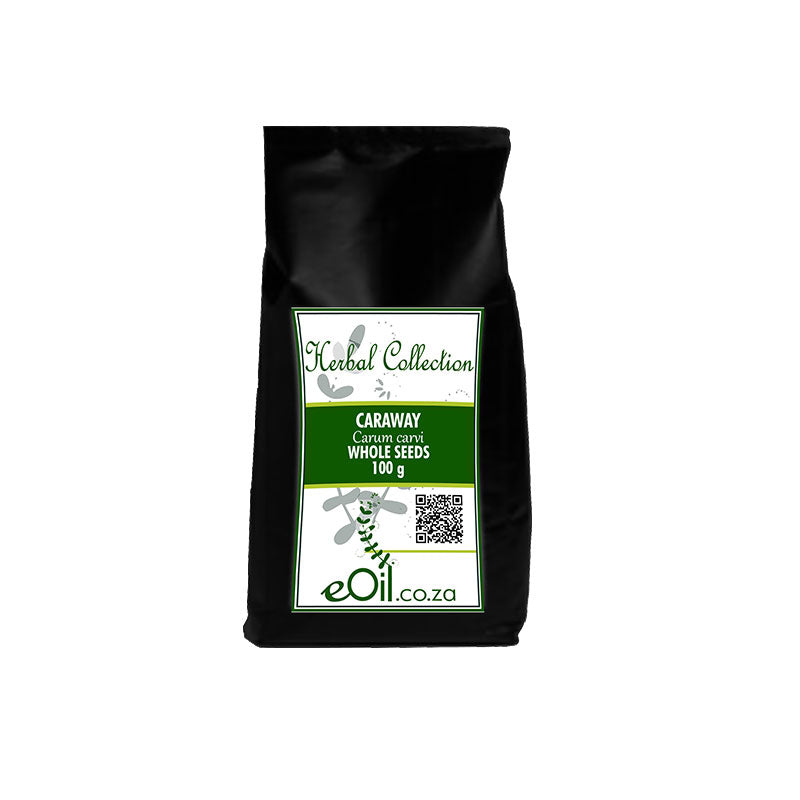Caraway Seeds Whole - Herbal Collection
Caraway Seeds Whole - Herbal Collection - 100 GR is backordered and will ship as soon as it is back in stock.
Description
Description
Caraway Seeds Whole (Carum carvi) offer a distinctive aroma and a warm, mildly sweet, anise-like flavor.
Widely used in traditional dishes, they are perfect for rye bread, stews, sauerkraut, and savory baking.
Naturally high in fiber and essential oils, caraway seeds are pure, versatile, and free from additives
TRADITIONALLY USED FOR
Caraway (Carum carvi) is a biennial herbaceous plant belonging to the Apiaceae family, native to Europe, Asia, and North Africa. Caraway seeds, which are technically fruits, have been used in traditional medicine and culinary practices for centuries. They are well-known for their distinctive aroma and flavor, and have a long history of use in various traditional remedies.
Traditional Uses:
- Digestive aid: Caraway seeds have been traditionally used to alleviate various digestive issues, including indigestion, bloating, gas, and stomach cramps.
- Respiratory support: Caraway seeds have been used as an expectorant to help relieve congestion, coughs, and other respiratory issues.
- Menstrual relief: Traditionally, caraway seeds have been used to ease menstrual cramps and regulate menstruation.
- Lactation support: Caraway seeds have been used to promote lactation in breastfeeding mothers, as they are believed to increase milk production.
- Antiparasitic: Caraway seeds have been used as a remedy for expelling intestinal parasites.
Properties:
- Carminative: Caraway seeds contain compounds that help relax the smooth muscles of the gastrointestinal tract, relieving gas and bloating.
- Antispasmodic: Caraway seeds possess antispasmodic properties, which can help alleviate cramps and spasms in the digestive system, as well as menstrual cramps.
- Expectorant: Caraway seeds have expectorant properties, which can help loosen and expel mucus from the respiratory tract.
- Galactagogue: Caraway seeds are considered a galactagogue, meaning they may help increase milk production in breastfeeding mothers.
- Antimicrobial: Caraway seeds contain antimicrobial compounds that may help fight against bacterial, fungal, and viral infections.
While caraway seeds have a long history of traditional use, it is important to note that more research is needed to fully confirm the effectiveness of these properties. As with any herbal remedy, individual results may vary, and it's essential to consult a healthcare professional before using caraway seeds for medicinal purposes, especially if you are pregnant, breastfeeding, or taking any medications.
INFORMATION
Source : http://www.wikiphyto.org/wiki/Carvi
Reference on http://www.wikiphyto.org
Translation in English by Google Translate (go to the page of the source linked | on Chrome cellphones go on the 3 dots on the top right and select translate in your preferred language | on laptop right click your mouse and select option translate when hoovering on the page
plant name
Caraway , Caraway , caraway (English)
International Latin denomination
Carum carvi L.
botanical family
Apiaceae ( Umbelliferae )
Description and habitat
- Biennial, aromatic herb, 60 cm tall, with leathery leaves, white flowers
- The capsules contain two seeds (ovoid diakene)
- Cultivated in Europe, North Africa, USA
- Sunny places up to 2000 m altitude
History and tradition
- Flavors Munster “with cumin”, musky flavor, warm and acrid, slightly burning
- Very old spice: it has been found in Neolithic lake dwellings
- Caraway fruits inhibit potato germination
- Not to be confused with real cumin Cuminum cyminum
Parts used
- Fruit, seed, seed essential oil
Dosage forms available
- Fluid root extract
- Seed tincture (fruit)
- Seed essential oil
Usual dosages
Composition
Main components of the plant
- Essential oil (3-8%) high in D-carvone = (-)-carvone (a ketone ) and limonene (90-98% of constituents)
- Phenylacrylic acids
- Flavonoids ( isoquercitrin , quercetin , miquelianin , astragalin )
- Furanocoumarins
- Lipids ( petroselinic acid 25%), proteins
- Polysaccharides
Main components of buds or young shoots
Main components of essential oil
- Ketone : D-carvone 50-80% = (-)-carvone = (R)-carvone = L(-)-carvone = L-carvone (one of the least neurotoxic ketones )
- Limonene up to 49%
- Monoterpene hydrocarbons : alpha-phellandrene , myrcene , para-cymene
- Sesquiterpene hydrocarbons : beta-caryophyllene , humulene (= alpha-caryophyllene ), cadinene , germacrene , elemene
Properties
Plant properties
- Stimulation of salivary, gastric and biliary secretions, facilitates peristalsis
- Antispasmodic of the intestinal muscles, anticolitic [1] , regulates the heart rhythm disturbed by digestive disorders
- Diuretic
- Expectorant
- Galactogen, emmenagogue
- Action comparable to that of green anise and fennel
Bud properties
Properties of essential oil
- Anticolitic [2] , antibacterial against pathogenic flora while respecting resident flora (microbiota) [3]
- Hepatoprotective, inhibits lipid peroxidation [4]
- Carvone is hepatic detoxifying. There are two enantiomers:
- La (-)-carvone = S-carvone ( D-carvone ), dextrorotatory in caraway seed , smelling of cumin and dill
- (+)-carvone = R -carvone ( L-carvone ), levorotatory has a spearmint smell
- The two molecules have a different smell even though their chemical composition is strictly the same
- Stimulates digestive secretions, but inhibits bile emptying [5] , facilitates gas expulsion
- Inhibitor of carcinomatous transformation in the colon [6] , [7]
- Antibacterial properties against pathogenic strains for plants and cultivated fungi [8]
- Possible use as a bioherbicide [9]
Directions
Indications of the whole plant (phytotherapy)
- Bloating and digestive disorders, decreases symptoms of dyspepsia [10] , colitis, colopathies
- Heart rhythm disturbances triggered by digestive problems (postprandial bloating)
- Milk deficiency
- Cough
- Amenorrhea
- Mucositis induced by chemotherapy and radiotherapy treatments (post-radiation), mixed in sesame oil [11]
Indications of the bud (gemmotherapy)
Specific indications of essential oil (aromatherapy)
- Bloating, dyspepsia, imbalance of the intestinal flora, dysbiosis
Known or suspected mode of action
Usual formulations
- Classic galactogenic herbal tea formula:
- Angelica Angelica archangelica seeds...30 grams
- Green anise Pimpinella anisum seeds...30 grams
- Fennel Foeniculum vulgare seeds ... 30 grams
- Caraway Carum caraway seeds...60 grams
- Hops Humulus lupulus cones ... 20 grams
- One teaspoon per cup. Boil 2 to 3 minutes, infuse 10 minutes. Drink 2 to 3 cups a day
Regulations
- French Pharmacopoeia list A (fruit)
Possible side effects and precautions for use
- HE prohibited in pregnant or breastfeeding women and children
- A large amount of seeds (for abortive purposes) or essential oil can cause nephritis
- Possible allergies
- Acute effects in animals of (-)-carvone : if ingested in large quantities, depression of the central nervous system, ataxia
- Chronic effects of (-)-carvone in animals : growth retardation, testicular atrophy
- Caution in case of hypothyroidism
Bibliographic references
- Go↑ Keshavarz A, Minaiyan M, Ghannadi A, Mahzouni P. Effects of Carum carvi L. (Caraway) extract and essential oil on TNBS-induced colitis in rats. Res Pharm Sci. 2013 Jan;8(1):1-8. PMID 24459470
- Go↑ Keshavarz A, Minaiyan M, Ghannadi A, Mahzouni P. Effects of Carum carvi L. (Caraway) extract and essential oil on TNBS-induced colitis in rats. Res Pharm Sci. 2013 Jan;8(1):1-8. PMID 24459470
- Go↑ Hawrelak JA, Cattley T, Myers SP. Essential oils in the treatment of intestinal dysbiosis: A preliminary in vitro study. Altern Med Rev. 2009 Dec;14(4):380-4. PMID 20030464
- Go↑ Samojlik I, Lakić N, Mimica-Dukić N, Daković-Svajcer K, Bozin B. Antioxidant and hepatoprotective potential of essential oils of coriander (Coriandrum sativum L.) and caraway (Carum carvi L.) (Apiaceae). J Agric Food Chem. 2010 Aug 11;58(15):8848-53. doi: 10.1021/jf101645n. PMID 20608729
- Go↑ Goerg, KJ, & Spilker, T. (2003). Effect of peppermint oil and caraway oil on gastrointestinal motility in healthy volunteers: a pharmacodynamic study using simultaneous determination of gastric and gall-bladder emptying and orocaecal transit time. Alimentary pharmacology & therapeutics, 17(3), 445–451. https://doi.org/10.1046/j.1365-2036.2003.01421.x PMID 12562459
- Go↑ Dadkhah A, Allameh A, Khalafi H, Ashrafihelan J. Inhibitory effects of dietary caraway essential oils on 1,2-dimethylhydrazine-induced colon carcinogenesis is mediated by liver xenobiotic metabolizing enzymes. Nutri Cancer. 2011;63(1):46-54. doi: 10.1080/01635581.2010.516473. PMID 21108126
- Go↑ Allameh A, Dadkhah A, Rahbarizadeh F, Ashrafi-Helan J, Fatemi F. Effect of dietary caraway essential oils on expression of β-catenin during 1,2-dimethylhydrazine-induced colonic carcinogenesis. J Nat Med. 2013 Oct;67(4):690-7. doi: 10.1007/s11418-012-0650-2. PMID 22418855
- Go↑ Iacobellis NS, Lo Cantore P, Capasso F, Senatore F. Antibacterial activity of Cuminum cyminum L. and Carum carvi L. essential oils. J Agric Food Chem. 2005 Jan 12;53(1):57-61. PMID 15631509
- Go↑ N. Dudai, A. Poljakoff-Mayber, AM Mayer, E. Putievsky and HR Lerner. Essential Oils as Allelochemicals and Their Potential Use as Bioherbicides. Journal of Chemical Ecology. Volume 25, Number 5, 1079-1089. http://www.springerlink.com/content/u36hm4747r113107/
- Go↑ Madisch A, Holtmann G, Mayr G, Vinson B, Hotz J. Treatment of functional dyspepsia with a herbal preparation. A double-blind, randomized, placebo-controlled, multicenter trial. Digestion. 2004;69(1):45-52. PMID 14755152
- Go↑ Mardani M, Afra SM, Tanideh N, Andisheh Tadbir A, Modarresi F, Koohi-Hosseinabadi O, Iraji A, Sepehrimanesh M. Hydroalcoholic extract of Carum carvi L. in oral mucositis: a clinical trial in male golden hamsters. Oral Dis. 2016 Jan;22(1):39-45. doi: 10.1111/odi.12375. PMID 26407909
- Muthaiyan Kamaleeswari, Namasivayam Nalini. Dose-response efficacy of caraway (Carum carvi L.) on tissue lipid peroxidation and antioxidant profile in rat colon carcinogenesis. Journal of Pharmacy and Pharmacology, 2006, 58 (8) pp 1121–1130 [1]
- Teuscher Eberhard, Anton Robert, Lobstein Annelise. Aromatic plants: Spices, herbs, condiments and essential oils. Ed. Tec & Doc. Cachan. 2005. p 174
- http://chem.sis.nlm.nih.gov/chemidplus/ProxyServlet?objectHandle=DBMaint&actionHandle=default&nextPage=jsp/chemidheavy/ResultScreen.jsp&ROW_NUM=0&TXTSUPERLISTID=0006485401
CAUTION
Store in a cool, dry place, away from light. Keep tightly closed, away from the reach of Children and pets.
Do not exceed the daily dose.
This product is not intended to prevent or cure any form of illness or disease.
If you are pregnant or nursing ; If you have a medical condition or are in the course of medical treatment ; If you are programmed for theater/operation in the near future, please consult your healthcare practitioner before using this product.
This product cannot replace a varied and balanced diet and a healthy lifestyle.
This product has not been evaluated by the SAHPRA for its quality, safety or intended use.
For More Information please check our General Safety Herbal products Page

Caraway Seeds Whole - Herbal Collection - 100 GR is backordered and will ship as soon as it is back in stock.






